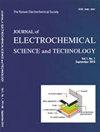pH和浓度对Al-7075 T6铝合金在NaCl水环境中电化学腐蚀行为的影响
IF 3
4区 工程技术
Q3 ELECTROCHEMISTRY
Journal of electrochemical science and technology
Pub Date : 2022-02-07
DOI:10.33961/jecst.2020.01214
引用次数: 0
摘要
本研究通过浸渍试验和电化学试验,在酸性、中性和碱性pH下,分别在1.75%和3.5%的NaCl环境中评价了Al-7075铝回火(T-6条件)合金的腐蚀行为。通过浸渍试验和电化学腐蚀试验(动电位极化和电化学阻抗谱试验)获得的数据表明,由于形成了致密且粘附良好的薄保护氧化物层,合金试样在溶液pH=7条件下的腐蚀速率最小。然而,与T6处理形成的沉淀金属间相(本质上是阴极)相比,具有酸性和碱性pH的溶液导致铝合金的腐蚀行为向更活跃的区域转移,由于介质中酸性和碱性离子(Cland OH-)的恒定流量而加剧,该介质阳极溶解了铝基体。因此,通过循环极化测试观察到,当溶液的pH从中性环境变为碱性环境时,合金的点蚀行为会转移到更活跃的区域,这是由于基体在碱性环境中的局部溶解,通过氧化膜中的孔扩散进入。微观分析也加强了通过浸渍腐蚀测试和电化学腐蚀测试获得的结果,因为该研究在海洋环境中对该合金的腐蚀行为进行了系统评估。本文章由计算机程序翻译,如有差异,请以英文原文为准。
Effect of pH and Concentration on Electrochemical Corrosion Behavior of Aluminum Al-7075 T6 Alloy in NaCl Aqueous Environment
In the present study, the corrosion behavior of aluminum Al-7075 tempered (T-6 condition) alloy was evaluated by immersion testing and electrochemical testing in 1.75% and 3.5% NaCl environment at acidic, neutral and basic pH. The data obtained by both immersion tests and electrochemical corrosion tests (potentiodynamic polarization and electrochemical impedance spectroscopy tests) present that the corrosion rate of the alloy specimens is minimum for the pH=7 condition of the solution due to the formation of dense and well adherent thin protective oxide layer. Whereas the solutions with acidic and alkaline pH cause shift in the corrosion behavior of aluminum alloy to more active domains aggravated by the constant flux of acidic and alkaline ions (Cland OH-) in the media which anodically dissolve the Al matrix in comparison to precipitated intermetallic phases (cathodic in nature) formed due to T6 treatment. Consequently, the pitting behavior of the alloy, as observed by cyclic polarization tests, shifts to more active regions when pH of the solutions changes from neutral to alkaline environment due to localized dissolution of the matrix in alkaline environment that ingress by diffusion through the pores in the oxide film. Microscopic analysis also strengthens the results obtained by immersion corrosion testing and electrochemical corrosion testing as the study examines the corrosion behavior of this alloy under a systematic evaluation in marine environment.
求助全文
通过发布文献求助,成功后即可免费获取论文全文。
去求助
来源期刊

Journal of electrochemical science and technology
ELECTROCHEMISTRY-
CiteScore
6.30
自引率
8.10%
发文量
44
期刊介绍:
Covering fields:
- Batteries and Energy Storage
- Biological Electrochemistry
- Corrosion Science and Technology
- Electroanalytical Chemistry and Sensor Technology
- Electrocatalysis
- Electrochemical Capacitors & Supercapcitors
- Electrochemical Engineering
- Electrodeposition and Surface Treatment
- Environmental Science and Technology
- Fuel Cells
- Material Electrochemistry
- Molecular Electrochemistry and Organic Electrochemistry
- Physical Electrochemistry
- Solar Energy Conversion and Photoelectrochemistry
 求助内容:
求助内容: 应助结果提醒方式:
应助结果提醒方式:


